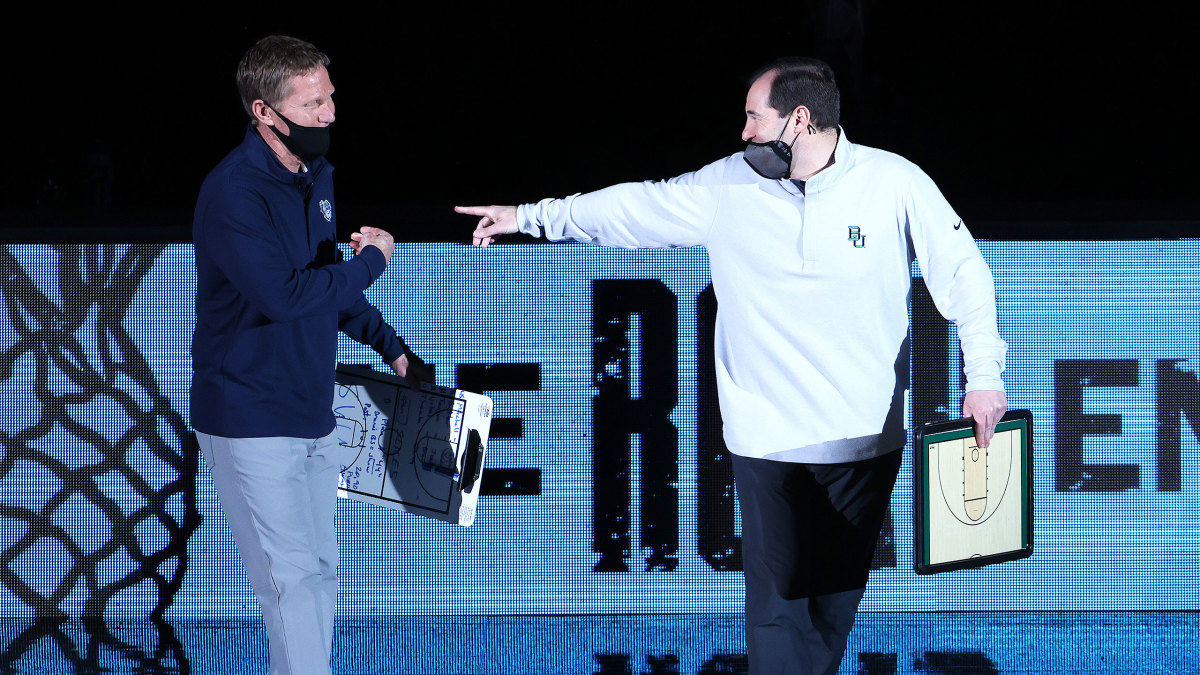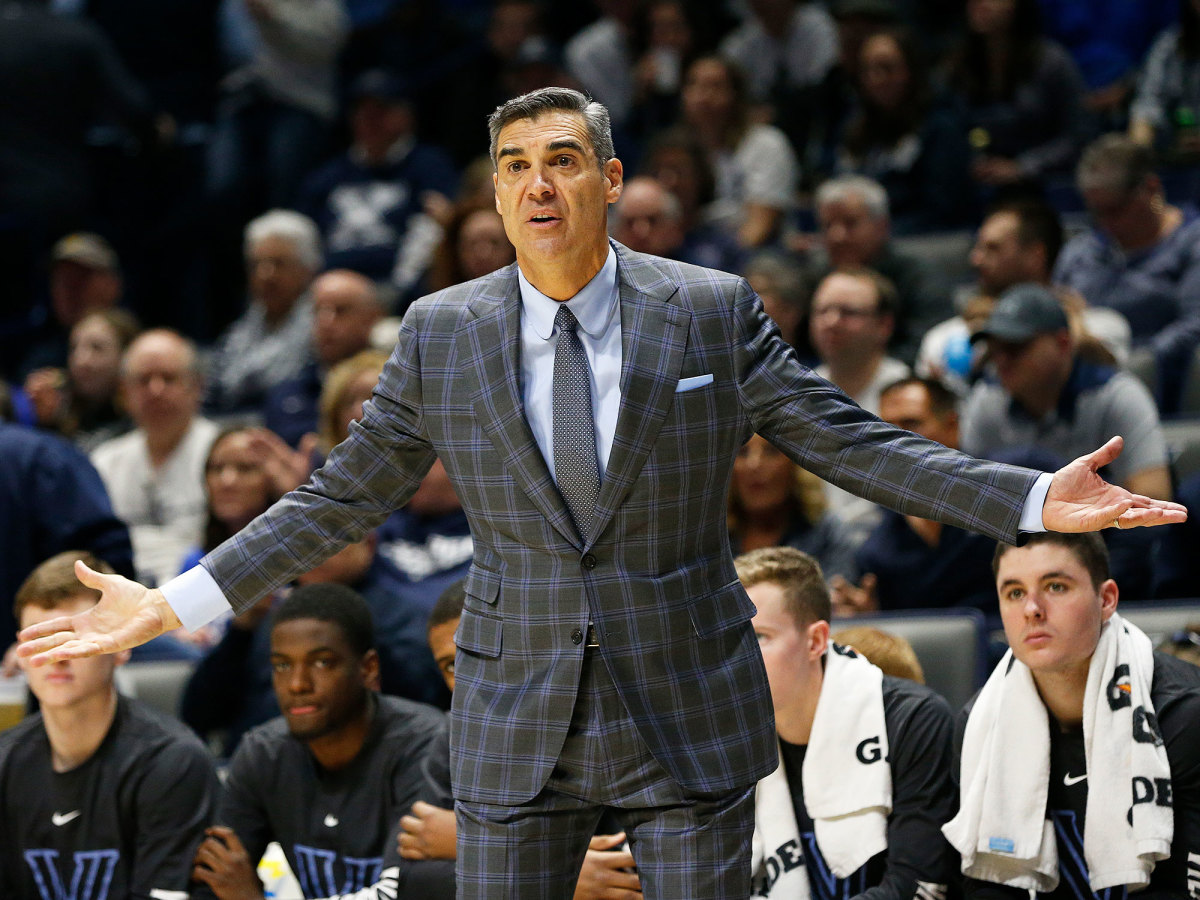Where Have the Suits on College Basketball's Sidelines Gone?
INDIANAPOLIS – As the most abnormal tournament in NCAA history unfolded, the empty stands and mask-covered faces hogged all the this-is-unusual attention. But another trend was obvious, right there on the sidelines, and it should last longer than the pandemic, stretching across sports.
Washington men’s coach Mike Hopkins first really noticed that college hoops had gone Basketball Casual when he saw Rick Pitino and his Iona staff dressed to impress in a first-round tourney loss. “They looked like they were in a freakin’ wedding,” Hopkins says, good-naturedly, noting that the sharp contrast made clearer how his brethren were now clothed. “Oh, s---,” Hopkins says he thought to himself. “Nobody’s worried about [style] anymore.”
Zip-ups, polos, pullovers and Nike Dri-FIT T-shirts infiltrated basketball this season, as coaches from the NBA to the men’s and the women’s brackets opted for less-formal attire for health reasons that stemmed from the pandemic. Dry-cleaning stylish wardrobes carried additional risk for contracting COVID-19. Some conferences, like the ACC and the Big Ten came to agreements that all of their coaches should dress the same, which is to say … like they’re headed to Costco for a hot dog on Saturday morning.

Given that most teams played in empty arenas, this change made perfect sense and called into question what many program heads have long wondered: Why did they wear suits and ties and the equivalent for women in the first place? Best anyone can surmise, that answer is simple: because almost everyone at the highest levels of basketball did.
Consider that the most obvious—and weakest—of explanations. Baseball managers wear uniforms, giving off an equally ridiculous but contrasting vibe. Football coaches don hats and athletic gear and, for one Hall of Fame style maven, long favored the cut-off hooded sweatshirt. Basketball czars, meanwhile, spent five figures on suit collections, despite drawing up plays in varied states of disheveled frenzy, sweating through their precious Armani, throwing jackets and, in Hopkins’s case and surely for others, ripping multiple pants. Yes, hockey coaches also dress up for games. But at least they’re standing next to the ice.
And yet, the suits persisted from the day that James Naismith donned a wool ensemble for his first game coaching at Kansas. UCLA’s John Wooden attired like a college professor. Villanova’s Jay Wright became Jay GQ. Pitino often resembled Al Pacino in Scarface. Suit game came to carry a remarkable, if not odd, importance; so much so that one college basketball scandal featured a custom-suit maker, Rashan Michel, who was ensnared in the FBI sting charged with bribery and fraud.
Sure, there were exceptions: Indiana’s Bob Knight in golf shirts (like the night when he threw the chair), Notre Dame’s Mike Brey in mock turtlenecks, George Raveling in tracksuits and Bob Huggins in, well, what might be best described as basketball pajamas or sportswriter chic. Who knew that Huggy Bear would end up a trendsetter? He liked to say that he wasn’t a banker and didn’t plan to ever dress like one.
On the women’s side, two of the best-ever coaches, Connecticut’s Geno Auriemma and the 2021 women’s champion, Stanford’s Tara VanDerveer, also long ago went quarter-zip. Adia Barnes, who led Arizona to the title game this season, sometimes wears Versace sneakers—and sometimes wears sweatpants. Not that there’s anything wrong with that, least of all for the apparel companies now banking free TV advertisements.
There is an exception, though: the traditionalists. “I hate to see it,” says Jim Nantz, the broadcaster who’s no stranger to Italian threads. “Jay Wright was making a statement every time he coached a game. I don’t want it to go away, but it’s a product of our time.”

Especially during the pandemic when most of the world shifted to working at home, dressing down, living in hoodies and sweatpants, Casual Friday now every day of the week. The NBA, of course, shut down first last March, and when pro hoops returned, bubble coaches dressed as if headed to an AAU tournament. The heroic dry cleaners who cleaned their sweat stains either rejoiced or lamented, depending on how much they needed the lost revenue.
The polo-donning NBA coaches included Rick Carlisle of the Dallas Mavericks, whose mentor, the late Chuck Daly, was “an old-school believer-slash-lover of haberdashery.” Daly seemed like the only coach at the 1992 Olympics who still wiggled into a custom ensemble, and he not only insisted his coaches follow, well, suit (sorry), he also went shopping with them at fancy stores all over the country. Daly once told Carlisle that he owned 200 (!!) suits, and that’s after he had handed a few down. To be fair, “they were unbelievably comfortable,” Carlisle says. “Like you’re wrapped in Heaven.” But they still cost thousands and made coaching, the very act in play for the stylish set, more difficult.
In the bubble Carlisle found the polos easier to wear, easier to clean and just easier in general. Not that he would have told Daly that. The $10,000–$20,000 he saved didn’t hurt, either.
Hopkins, the UW coach, says coaches often complained—their specialty—about designer threads. But sometimes, he also saw the value in them. One booster didn’t like the purple hue of his tie and even gave him a replacement that better matched the Huskies’ colors, reinforcing that some people did care how he dressed for games. Someone else told him his suits were too baggy, so, yes, people were watching and analyzing something that should never be analyzed. Namely, what a college basketball coach wears. It’s worth asking, Hopkins implores, “Are we setting a good or a bad example?” with Basketball Casual.
“Are we an example for the athletes or the people who watch on television?” he continues, unable to answer his own question.
Asked whether he’d ever go full Bill Belichick, Hopkins laughs. “You’d have to win a lot of games,” he says.
On the heartbreaking side of this trend, the iconic tailor who made tuxes for Frank Sinatra and outfitted comedian George Burns and baseball star Mike Schmidt also stitched and hemmed something like 50 suits for Wright. His name was Gabriele D'Annunzio and he founded D&B Tailors outside of Philadelphia in 1966. Wright would even purchase suits for his graduated seniors after every season.
About six months ago according to one of two store managers, Christine Newell, D’Annunzio started to bemoan the Basketball Casual trend. “He was definitely bummed out,” she says, and she means as much by the lost art as the lost revenue from both the tailor business and the dry cleaning one. This was a man who still tugged on custom threads every day so that he could create … suits. Made sense. And he wanted his coaches to do the same because of what that suit signified, the meaning behind his life’s work.
Worse yet, D’Annunzio came down with COVID-19 and died in January from a combination of the coronavirus and the pneumonia he contracted. In his absence revenue continued to sink, as customers bought more golf clothes but fewer suits. “We’re trying to continue,” Newell says. “But people are not getting dressed up. It’s just really, really hard; it’s killing our business.”
Still, she remains hopeful that the suit-style of basketball coaching will return at some point after the pandemic ends. She hopes that Wright brings it back, to honor D’Annunzio. “He’s the right guy for it,” she says.
Others aren’t so sure. The mock turtleneck wonder, Brey, says in a text message that he would go back to a suit if he could erase this pandemic season. “Hell, maybe I should even wear a tie,” he wrote.
Most don’t see any Armani in the future, unless Barnes rocks the luxury brand’s shoes. Not for a long time, anyway, if ever. “I’m afraid they’re not coming back,” Nantz says, a bit wistfully.
